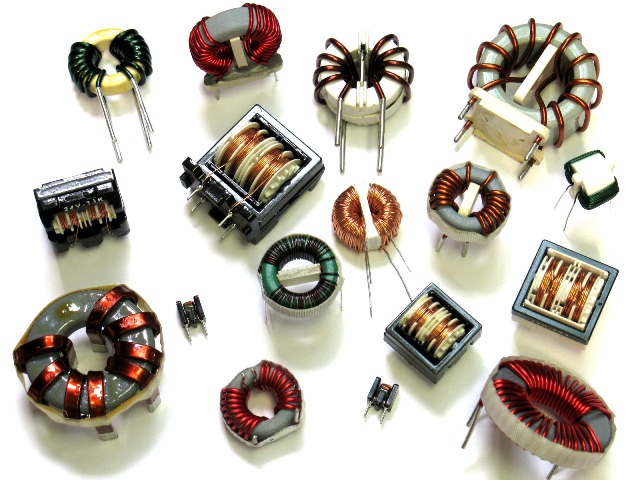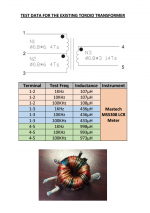I have desoldered the transformer from a car amp(TAS5630) board. It is used here in the push-pull stage to step up the voltage from 12V battery. Now I need to know which core material is used here.
I have tested the end to end inductance with a LCR meter. From the inductance value, it is definitely not PC-40 material. What core material it can be ? any idea ?
I have tested the end to end inductance with a LCR meter. From the inductance value, it is definitely not PC-40 material. What core material it can be ? any idea ?
Attachments
I can see the toroid is blue, looks like an Arnold Powder Core, however your inductance measures high like a ferrite . I wonder if it's a Permalloy Core, or just a blue colored ferrite.
Is knowing your core material mandatory? If you are reusing it as a transformer, then you already know it works, so core material shouldn't be a major concern, unless you were rewinding the transformer for other uses.
Is knowing your core material mandatory? If you are reusing it as a transformer, then you already know it works, so core material shouldn't be a major concern, unless you were rewinding the transformer for other uses.
1.1cm² is plenty: with commonly available power ferrites, a 12V winding requires ~2 to 3 turns.Yes. the torroid is blue in color. I am interested to know it that which material is capable of conversion of 300W of power at 30Khz, 1.1cm2 core area like this one.
This allows you a comfortable copper section. Typical ferrites grades are N41, N51, N87 for Epcos (formerly Siemens), 3F35, 3C92, 3C93 for Ferroxcube (formerly Philips).
Almost all manufacturers have similar grades available, and the examples I gave are typical, but many others would be usable: most of the Nxx for Epcos, and most of 3Cxyz for Ferroxcube
The switching transistors could blow instantly if Bsat is too low, and the ferrite could become boiling hot if it has too high losses for the frequency/induction of operationWhat would be the symptoms of using the wrong ferrite material?
What would be the symptoms of using the wrong ferrite material?
Hot MOSFETS, Hot Core, Lots of Power consumption for low load......
In my earlier learning days, I used a large yellow/white iron powder core as a transformer, 7+7 primary turns, and the symptoms were heating of the transformer at no load, and when pulling high current from the secondary, a sudden sharp increase in temperature of the MOSFETS, which led to then blowing up. I assume this is due to the lack of inductance of that core type at only 7 turns. However, it did work as a transformer......
However with a ZF42910TC Ferrite Core, I made a 19.5V Laptop converter with only 5+5 Primary Turns, and produces very little heat at all in the MOSFETS or in the core even at testing over 200W, and have had no failures, even accidently shorting the power supply.
What would happen if you use ferrites intended for interference control, ie filters but at low frequency , ie sub 100 kHz, fex in a power transformer?
I have some quite large toroids but material is totally unknown, but likely used for emi suppresion, ie filters fex at variable freuency drives.
Was thnking about playin a bit with these.
How do these ferrites differ from ordinary power ferrites like 3F3 and similar?
I am not worried about saturatin, they have huge crossection ( smallest is 250 mm2)
I have some quite large toroids but material is totally unknown, but likely used for emi suppresion, ie filters fex at variable freuency drives.
Was thnking about playin a bit with these.
How do these ferrites differ from ordinary power ferrites like 3F3 and similar?
I am not worried about saturatin, they have huge crossection ( smallest is 250 mm2)
Often interference control ferrites are NiZn types, rather than the more common MnZn. They have lower losses at HF but also lower mu. Using NiZn material for a trafo core I reckon you'll be pushed to get enough inductance. But if the frequency's high enough that may not matter. It all depends how much 'sub 100kHz' you want to go.
The ones used in LF CMC's are almost universally MnZn types, but not the variety used for the power transfer: in general they have a very large µ, a lower saturation limit than power ferrites and are also more dissipative. A typical example is the T38 Epcos.What would happen if you use ferrites intended for interference control, ie filters but at low frequency , ie sub 100 kHz, fex in a power transformer?
That said, they are still usable for transformers and power chokes, but you should operate them at a lower induction than dedicated types: 200 to 300mT is reasonable, even lower if you work at high frequencies.
It is easy to tell MnZn from NiZn: the MnZn have a much lower DC resistivity.
If you put the test tips of an ohmmeter directly in contact with the material (beware, they are often coated, sometimes in black), you will typically read a few KΩ or tens of KΩ. With Ni ferrites, the resistance will normally be >20MΩ
The ones used in LF CMC's are almost universally MnZn types, but not the variety used for the power transfer: in general they have a very large µ, a lower saturation limit than power ferrites and are also more dissipative. A typical example is the T38 Epcos.
That said, they are still usable for transformers and power chokes, but you should operate them at a lower induction than dedicated types: 200 to 300mT is reasonable, even lower if you work at high frequencies.
It is easy to tell MnZn from NiZn: the MnZn have a much lower DC resistivity.
If you put the test tips of an ohmmeter directly in contact with the material (beware, they are often coated, sometimes in black), you will typically read a few KΩ or tens of KΩ. With Ni ferrites, the resistance will normally be >20MΩ
For the sake of this topic, and to help other DIY'ers that visit this thread............So does that mean we can use the little toroid ferrites we find in CRT monitors, and other circuits that typically wrap their wires through them, as transformer core, just don't push them so hard..........correct?
Also, any of you folks here used CRT ferrite yokes as transformers? You can get a pretty good cross-section if you pick the thicker ones, that are less bellshaped. CRT monitor yokes, and certain TV's have some really beefy ones. You can get them from projection TVs also that are not bell-shaped. I have a COLLECTION of them, and I'm always collecting more........there are also lots of folks on youtube using them as high voltage step transformers for CFL and LED bulbs.
No, these are typically NiZn toroids, and they won't get you very far for power applications.For the sake of this topic, and to help other DIY'ers that visit this thread............So does that mean we can use the little toroid ferrites we find in CRT monitors, and other circuits that typically wrap their wires through them, as transformer core, just don't push them so hard..........correct?
I am talking about common mode chokes; they look like this:

In principle, yes, they are the right variety, but the problem is that they do not have an homogeneous Lf, which means you'll never be able to use the full section at the same time: the smaller diameter part will saturate firstAlso, any of you folks here used CRT ferrite yokes as transformers? You can get a pretty good cross-section if you pick the thicker ones, that are less bellshaped. CRT monitor yokes, and certain TV's have some really beefy ones.
Problem is to get a good coupling between prim and sec windings.
Build LLC and you don't need good coupling, opposite to that you need "bad" coupling
Thanks for the reply. I am not worried about saturation , easy to layout a winding sufficient to keep induction <100 mT under normal conditions. Problem is to get a good coupling between prim and sec windings.
Good coupling is easyily achieved with toroid cores as long as you avoid sectional windings found with common mode chokes.
Build LLC and you don't need good coupling, opposite to that you need "bad" coupling
Intentional bad coupling stores energy in the core.
Storing energy in the core invites core loss to waste it.
You should not store more energy than needed to empty
COSS for the next "zero voltage" -.7V switch transition.
If not wasted by the core, its burned by imperfect body
diode clamping, while we wait for the MOSFET's channel
to turn on.
Energy stored in capacitance is related to rails voltage
and probably does not change much with load. On the
other hand, energy stored in bad coupling is influenced
by the load. If the load changes at all, you will over or
undershoot the optimum stored energy.
Lately, I'm thinking shim inductor with purposely limited
and extremely square storage. Ferrite, maybe cobalt.
------
As for bad being better: I think lots of parallel MOSFET
with big non-linear COSS. More near rails, less halfway.
Your turn offs are softened because the volts then can't
jump away from the rails too fast.
Of course: Adding capacitance across COSS, or just more
COSS, is a grenade if you don't correctly set up and take
advantage of a soft switch opportunity every turn-on.
Last edited:
- Status
- This old topic is closed. If you want to reopen this topic, contact a moderator using the "Report Post" button.
- Home
- Amplifiers
- Power Supplies
- Identyfying ferrite core material
